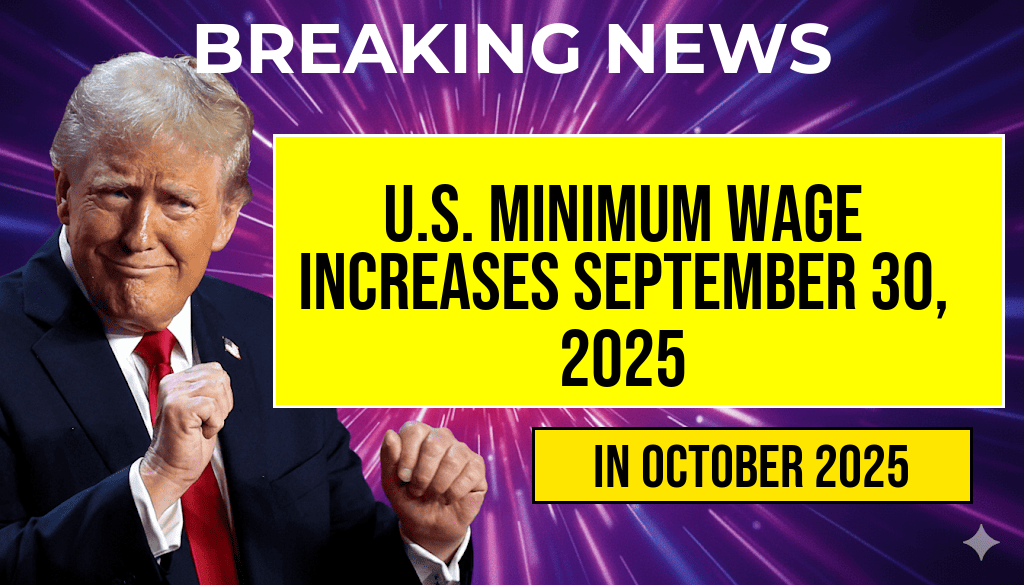The U.S. minimum wage is scheduled to increase on September 30, 2025, marking a significant shift in wage policy aimed at improving the financial stability of millions of American workers. This increase is part of a phased approach that advocates for a more livable wage, responding to rising living costs and inflationary pressures. As part of this change, a comprehensive hourly wage list will be made available to help workers and employers understand the new pay scales across various industries and regions. The forthcoming adjustments are expected to impact both urban and rural areas differently, reflecting the diverse economic landscapes throughout the country.
Details of the Minimum Wage Increase
The federal minimum wage, which has been set at $7.25 per hour since 2009, will see its first increase in over a decade. The planned increase will be implemented in stages, ultimately raising the federal minimum wage to $15 per hour. Various states and localities have already implemented their own minimum wage increases, with some areas exceeding the federal standard.
Impact on Workers and Businesses
The increase in the minimum wage is expected to have a profound effect on low-wage workers. According to a report from the Economic Policy Institute, approximately 32 million American workers are expected to benefit from the wage hike, which could lift many out of poverty.
- Workers’ Perspective: Many advocates argue that a higher minimum wage will improve the standard of living for low-income families, allowing them to afford necessities like housing, healthcare, and education.
- Business Concerns: On the other hand, some business owners express concerns about the potential for increased labor costs, which may lead to higher prices for consumers or reduced hiring.
State and Local Minimum Wage Trends
While the federal minimum wage increase is significant, it is essential to recognize that many states and cities have already enacted higher minimum wage rates. For example, California and New York have established minimum wages of $15 per hour, with further increases planned in the coming years.
| State | Minimum Wage |
|---|---|
| California | $15.00 |
| New York | $15.00 |
| Florida | $11.00 |
| Texas | $7.25 |
| Washington | $15.74 |
Preparing for the Change
Employers are encouraged to start preparing for the minimum wage increase by evaluating their current pay structures and considering how the new rates will affect their business operations. Transitioning to a higher wage floor may involve adjusting pricing strategies, re-evaluating budgets, or investing in employee training to improve productivity.
Resources for Workers and Employers
The U.S. Department of Labor has committed to providing resources that will help both workers and employers navigate the upcoming changes. These resources include informational guides, FAQs, and tools for calculating payroll adjustments. Workers can also visit platforms like the Department of Labor to learn more about their rights and protections under the new wage laws.
Community Response
Community organizations and labor unions are actively engaging in discussions about the minimum wage increase. They emphasize the importance of continuing to advocate for workers’ rights and ensuring that the implementation of the new wage structure is equitable. Public forums and informational sessions are being organized to educate workers about the changes and to hear from various stakeholders about potential challenges.
Conclusion
As the U.S. prepares for the minimum wage increase on September 30, 2025, the move is seen as a crucial step toward addressing economic inequality and providing fair compensation for labor. With a comprehensive hourly wage list projected to be available soon, both workers and employers will have the tools necessary to navigate the changes effectively. The evolving landscape of wage policy reflects ongoing discussions about the value of work and the importance of ensuring that all Americans can earn a living wage.
Frequently Asked Questions
What is the new U.S. minimum wage rate effective September 30, 2025?
The new U.S. minimum wage rate will increase to $15 per hour, providing a significant boost for many workers across the nation.
How will the minimum wage increase affect hourly workers?
The minimum wage increase will directly benefit hourly workers by raising their earnings, which can help improve their overall financial stability and purchasing power.
Where can I find a comprehensive hourly wage list?
A comprehensive hourly wage list detailing the new minimum wage rates and other relevant wage information will be made available through government resources and labor organizations.
Are there any exceptions to the minimum wage increase?
Yes, certain exceptions may apply, such as for tipped employees, youth workers, and some small businesses, which may be subject to different wage standards.
What should employers do to prepare for the minimum wage increase?
Employers should review their current pay structures and ensure compliance with the new minimum wage laws, adjusting salaries and budgets accordingly to avoid potential penalties.

Leave a Reply